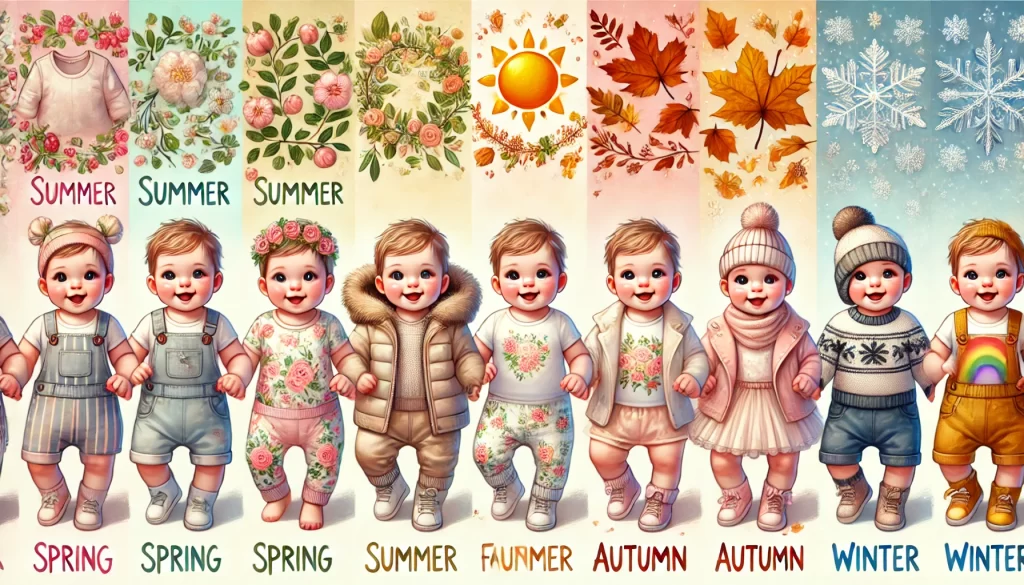Table of Contents
Dressing Baby Every Season
Dressing your baby appropriately for every season can be a challenge, especially for new parents. This guide will help you navigate each season with practical tips and recommendations for selecting the best clothes for your baby. Whether you’re wondering how to dress a newborn according to the seasons or looking for the perfect outfit, this Guide to Seasonal Baby Clothes: Dressing Your Little One will provide valuable insights to keep your baby comfortable and happy all year long.
Babies’ bodies are much more sensitive to changes in temperature than adults. Their inability to regulate body heat as efficiently means that dressing them for the season is not only a matter of comfort but also safety. When the temperature rises or drops, their clothes must adjust to ensure they stay cozy without overheating or freezing. This comprehensive guide will walk you through how to keep your baby stylish and, most importantly, safe through the four seasons.
When dressing your baby for varying seasons, it’s crucial to prioritize comfort and temperature regulation. According to the Children’s Hospital of Philadelphia, babies can lose heat much more quickly than adults, making it essential to select appropriate clothing that helps maintain their body temperature. Understanding the best fabrics and layering techniques can make a significant difference in keeping your little one comfortable year-round.
As you navigate the challenges of dressing your baby for different seasons, it’s also essential to prioritize safety during bath time. Understanding safe bathing practices for newborns and toddlers can ensure a comfortable and secure experience for both you and your little one. For valuable tips on how to create a safe bathing environment, including ideal water temperatures and necessary supplies, check out our article on Safe Bathing Practices for Newborns and Toddlers. By combining proper dressing techniques with safe bathing habits, you can help keep your baby happy and healthy throughout the year.
Understanding Baby’s Clothing Needs by Season
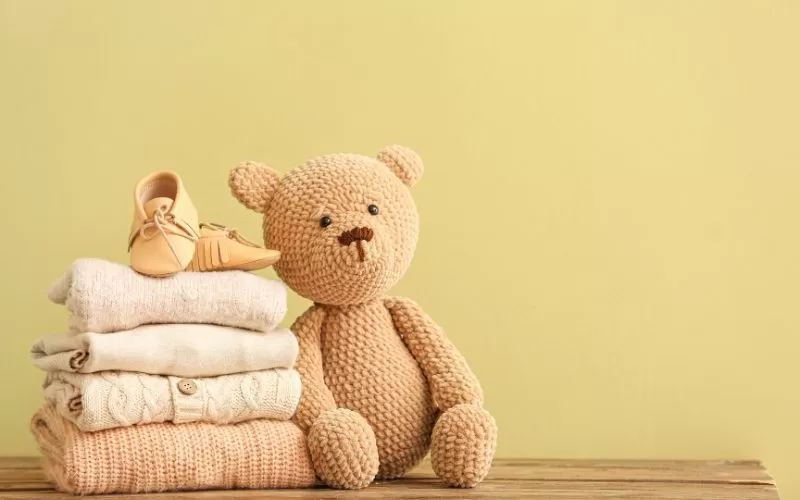
It’s important to remember that babies are not miniature adults; their needs for comfort and warmth differ significantly. A baby’s body retains and releases heat differently, and they are more susceptible to extremes in temperature. Therefore, understanding how to layer clothing for the season and choosing appropriate materials is essential to ensure your baby’s well-being.
For instance, during both cold and hot months, start with breathable layers. A versatile piece like our Organic Cotton Onesie is perfect as a base layer in any season. Cotton is breathable, gentle on sensitive skin, and easy to layer with other garments depending on the weather.
Important Tips:
- Always feel your baby’s neck or chest to check if they’re too hot or cold.
- Layering is key in every season for flexibility.
- Avoid overdressing, as it can lead to overheating.
Dressing Your Baby for Warm Weather

Summer heat can be challenging for babies, especially because they are more prone to heat rashes and dehydration. When dressing your baby in hot weather, light, breathable fabrics such as cotton or muslin are essential. These materials allow air to circulate and help to wick away moisture, keeping your baby cool and comfortable.
In warmer temperatures, you’ll want to minimize the layers while still ensuring their delicate skin is protected from the sun. Opt for lightweight clothes such as our Summer Baby Romper, which allows airflow while keeping your little one cool. Pair this with a wide-brimmed hat to shield them from direct sunlight.
When dressing your baby for different seasons, it’s essential to also consider their comfort during bath time. For helpful tips on ensuring their safety during these routines, check out our guide on Safe Bathing Practices for Newborns and Toddlers.
How to dress a newborn according to the seasons in summer:
- Choose breathable fabrics like cotton.
- Dress in light layers for flexibility.
- Include sun protection gear like hats and breathable blankets.
Summer Clothing Essentials for Babies:
- Light onesies and rompers made from natural fabrics.
- Hats to protect the baby’s head and face from the sun.
- Lightweight cotton blankets for sun protection while on the go.
While indoors, aim for one layer of clothing less than what you would wear. Outdoors, a light cotton outfit is usually sufficient, but always monitor their body temperature by checking their neck, chest, or back. Babies often need fewer clothes than parents assume in the summer months, so it’s essential not to overdress them.
How to Dress a Newborn According to the Seasons
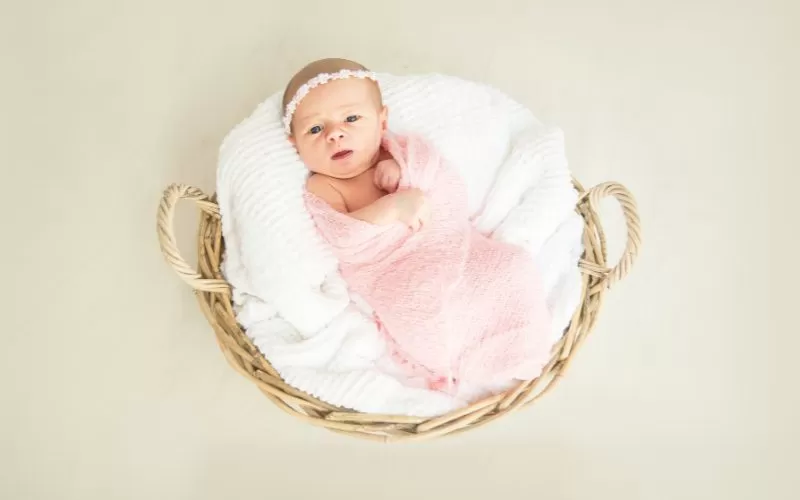
Newborns, especially in their first few months, have extra sensitive skin and are still developing their ability to regulate body temperature. As a result, dressing them according to the season becomes critical. During the cooler months, dressing your newborn in multiple layers allows you to adjust their clothing based on the temperature.
A simple layering strategy involves starting with a soft base, like a bodysuit, and adding warmer outer layers as necessary. Our Fleece Baby Jacket is an excellent choice for cold weather. In winter, layering helps trap warmth, but make sure the layers aren’t too bulky to restrict movement.
How to dress a newborn according to the seasons in cold weather:
- Begin with a base layer, preferably cotton, to maintain comfort.
- Add thicker layers such as fleece or wool for warmth.
- Always include a hat and socks to keep extremities warm.
Winter Clothing Essentials for Babies:
- Cotton base layers such as onesies or bodysuits.
- Fleece jackets or hoodies for extra warmth.
- Mittens, hats, and socks to keep tiny extremities cozy.
Dressing Your Baby for Cold Weather

Winter poses its own set of challenges for babies, especially those under six months old, as they cannot regulate their body heat as well as older children. The trick to dressing your baby in cold weather is layering while ensuring that none of the layers are too tight or bulky.
Wool, fleece, and insulated fabrics are your go-to options when dressing your baby for winter outings. Babies should have a base layer that sits close to the skin, such as a onesie, followed by a second layer like a fleece jacket or snowsuit.
Our Winter Baby Snowsuit offers excellent protection against cold temperatures while still allowing freedom of movement. Be mindful not to over-bundle your baby if they’ll be sitting in a car seat, as too many layers can create safety issues.
Dressing Your Baby for Various Seasons: During winter, layer wisely. Use breathable, soft materials for base layers and choose outerwear that insulates heat without restricting movement.
Winter Dressing Tips:
- Layer with cotton, fleece, and wool.
- Add mittens, hats, and insulated booties.
- Avoid overly bulky layers that could hinder your baby’s ability to move freely.
Transitional Seasons: Spring and Fall
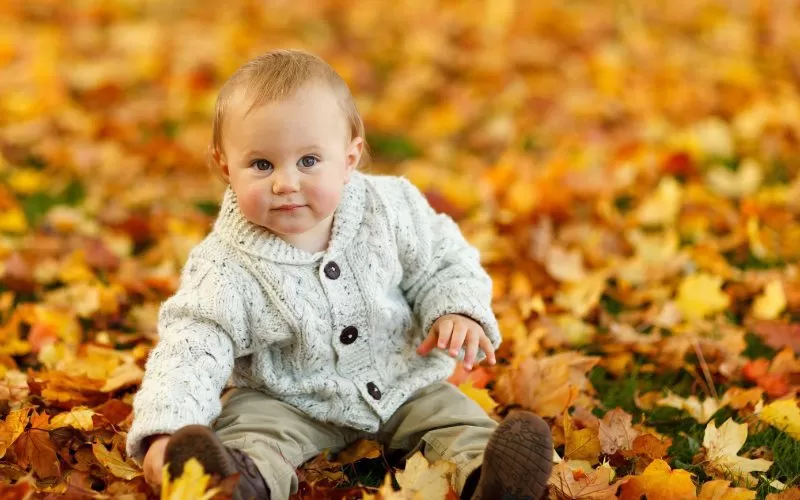
Spring and fall are known for their unpredictable weather, with temperatures fluctuating between warm and chilly throughout the day. This makes layering essential so you can quickly add or remove clothing based on the weather. In these transitional seasons, it’s important to strike a balance between warmth and breathability.
Start with a base layer, like a onesie or light cotton bodysuit, and add a Light Baby Sweater for those cooler mornings and evenings. The key here is to ensure flexibility so that layers can be easily adjusted throughout the day.
Dressing Your Baby for Various Seasons: Adapting to the Climate
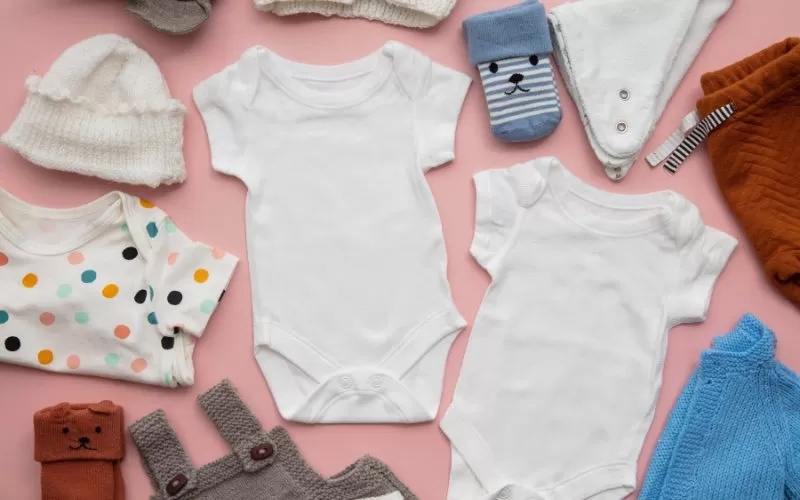
No matter the season, it’s crucial to adapt your baby’s wardrobe to changing weather conditions. This might involve a mixture of warm and cool weather clothes that can easily be interchanged. Make sure you have a few go-to staples for each season, such as cotton onesies, wool sweaters, and fleece outerwear, to ensure your baby is dressed appropriately.
As a part of this Guide to Seasonal Baby Clothes: Dressing Your Little One, it’s helpful to remember that babies often need extra attention to clothing. Layers are essential in cooler months, while breathable, natural fabrics are the key to comfort during warm months.
Pro-Tips for Every Season:
- In cold weather, always check the baby’s hands and feet to ensure they’re warm but not sweaty.
- In hot weather, prevent heat rash by keeping your baby’s clothes lightweight and breathable.
- During transitional seasons, be prepared to add or remove layers based on the baby’s comfort level.
When dressing your baby for different seasons, it’s essential to consider their unique skin needs, especially if they have sensitive skin. Choosing the right fabrics and materials can help prevent irritation and discomfort. For a deeper understanding of how to select baby clothes that are gentle on delicate skin, be sure to check out our article on How to Choose Baby Clothes for Sensitive Skin. This guide offers valuable insights into fabric types, recommended materials, and tips to ensure your little one stays comfortable throughout the year
Conclusion: Dressing Smart for Every Season
Understanding how to dress a newborn according to the seasons and the importance of layering will keep your baby comfortable and happy throughout the year. Be mindful of the temperature changes each season brings, and always prioritize comfort, breathability, and warmth in your baby’s wardrobe.
By using this Guide to Seasonal Baby Clothes: Dressing Your Little One, you’ll not only ensure your baby is stylish and snug but also safe and healthy. Investing in high-quality clothing like the ones mentioned from our store will help you tackle the challenges of seasonal dressing with ease. With the right approach, dressing your baby for any weather can be a breeze!

